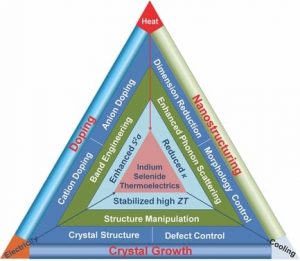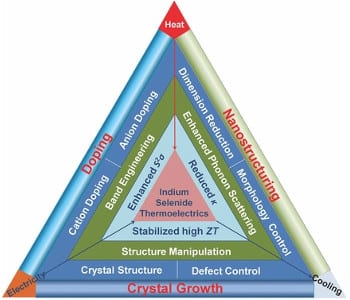 A major impetus in the development of modern civilization has involved various methods of energy generation, conversion and use. Because electricity will remain the most convenient form of energy in the foreseeable future, sustainable and eco-friendly methods with which to generate electricity are of extreme importance. On the other hand, heat has been always an abundant but low quality source of energy, as more than half of all the energy that we generate is lost as waste heat. The demand for alternative energy technologies to reduce our reliance on fossil fuels and the resulting greenhouse emissions hence leads to important regimes of research, including that of direct thermal-electrical energy conversion via thermoelectricity.
A major impetus in the development of modern civilization has involved various methods of energy generation, conversion and use. Because electricity will remain the most convenient form of energy in the foreseeable future, sustainable and eco-friendly methods with which to generate electricity are of extreme importance. On the other hand, heat has been always an abundant but low quality source of energy, as more than half of all the energy that we generate is lost as waste heat. The demand for alternative energy technologies to reduce our reliance on fossil fuels and the resulting greenhouse emissions hence leads to important regimes of research, including that of direct thermal-electrical energy conversion via thermoelectricity.
Thermoelectricity is the simplest technology applicable for direct heat-electricity energy conversion. Heat from different sources such as solar heat, geothermal heat, and waste heat from automobiles or other industrial processes can be directly converted into clean electricity by a thermoelectric device. A thermoelectric device can also work in reverse as a heat pump. Thermoelectric devices are of all solid-state assembly, are lightweight and compact, and have rapid responsiveness. They have no moving parts or hazardous working fluids, and can be miniaturization. The modular aspects of thermoelectric devices make it easy to work in tandem with other energy conversion or alternative energy technologies. This is a very important feature because no single technology can meet the world’s energy needs in the 21st century; one needs a combination of many technologies.
The conversion efficiency of a thermoelectric device is determined by the dimensionless figure of merit of thermoelectric materials, zT. A high zT requires a high thermpower (Seebeck coefficient), a high electrical conductivity and a low thermal conductivity. Developing high performance bulk materials with high zT is the central theme for the large scale application of thermoelectric technology. Up to now, the zT values of the traditional best-known thermoelectric materials have been close to unity. The most recent work on zT improvement is focused in two directions: one is to reduce the lattice thermal conductivity by enhancing phonon scattering, such as forming solid solutions or nanostructuring; the other is the modification of band structure. In the past decades, many efforts have also been concentrated on the research and development of novel thermoelectric materials.
Now the scientists at The University of Queensland, Australia have summarized recent progress on the structural characteristics, synthetic methods and thermoelectric properties of a new class of thermoelectric materials, indium selenides, aiming to shine some light on the possible approaches for thermoelectric performance enhancement of indium selenides as new high-efficiency thermoelectric materials for waste heat energy harvesting in a review article published in Small.
Indium selenides, especially In4Se3 materials, have recently been identified as promising high efficiency thermoelectric due to their extraordinary and tunable electrical and thermal properties. High zT values of ~1.5 at 700K have been reported for both In4Se3 single crystals and polycrystalline samples. The researchers first examined the structural characteristics and synthetic method of indium selenides. Indium selenides contain various complex compounds with different stoichiometric ratios, such as In4Se3, In2Se3, InSe, In6Se7 and In3Se4. With the same stoichiometric ratio, different phases and crystal structures may coexist, such as a, b and g–In2Se3, and hexagonal and rhombohedral InSe. The phase transformation and crystal structure of these compounds have been studied through XRD, TEM and DTA. Their fabrication methods generally include melting, single crystal growth, and physical and chemical vapor deposition. As for the nanostructures of indium selenides, because nanostructuring may result in enhanced phonon scattering and hence reduced lattice thermal conductivity, vapor-phase and solution-phase synthesis have been applied. The group provide comprehensive summaries of indium selenides in this review article, including crystal structures, lattice parameters, phase transformations, synthetic methods, nanoscale morphologies and thermoelectric properties of almost all of these indium selenides.
The thermoelectric properties of indium selenides are strongly dependent on their intrinsic structural characteristics, including compositions, phases, crystal structures, and structural imperfections. Among all reported indium selenides, In4Se3 shows a relatively low bandgap. A noticeable feature of In4Se3-x is its very low thermal conductivity due to the Peierls lattice distortion and pronounced phonon scattering at the Se-deficent sites, which is the main cause of the high zT of ~1.5 in this system. However, the carrier concentration of this compound is much lower than optimum carrier concentration, doping has been employed to maximize its electrical power factor and hence zT. It is also noteworthy that the thermoelectric properties of In4Se3 are anisotropic due to layered crystal structure. Many investigations have been carried out to explore the polycrystalline In4Se3, in order to obtain isotropic thermoelectric properties and to reduce fabrication cost. Nanostrucruing, Se deficiency self-doping and Pb/Sn co-doping have been employed to enhance thermoelectric properties. However, some research results on zT values are significantly different and even contradictory. It still remains as an open question that whether and how their thermoelectric properties can be further enhanced.
Overall, this review presents a comprehensive summary of the current understanding of the structural characteristics (crystal structures, phase transformations and structural vacancies), controllable synthesis (bulk materials, thin films and nanostructures) and thermoelectric properties of indium selenides. Current challenges and opportunities are proposed. Although high zT values for In4Se3 need to be seriously re-checked taking the measurement and phase stability into consideration, the related research indeed opens up an opportunity for understanding thermal and electrical transport and searching for possible approaches for thermoelectric performance enhancement.

















